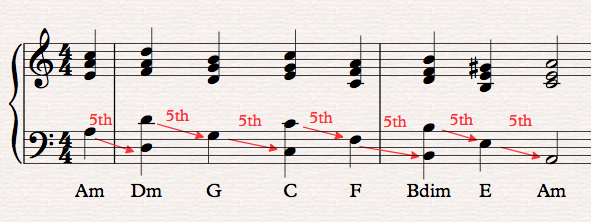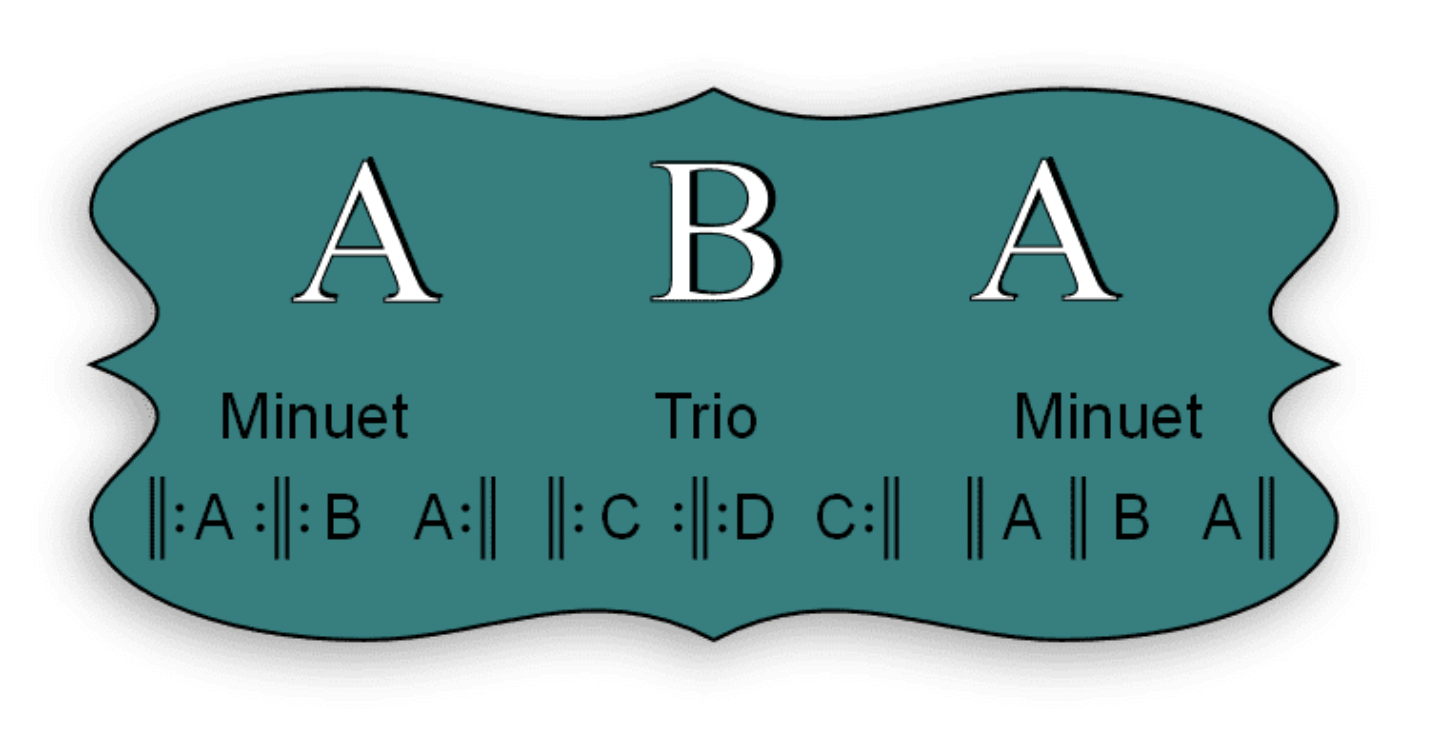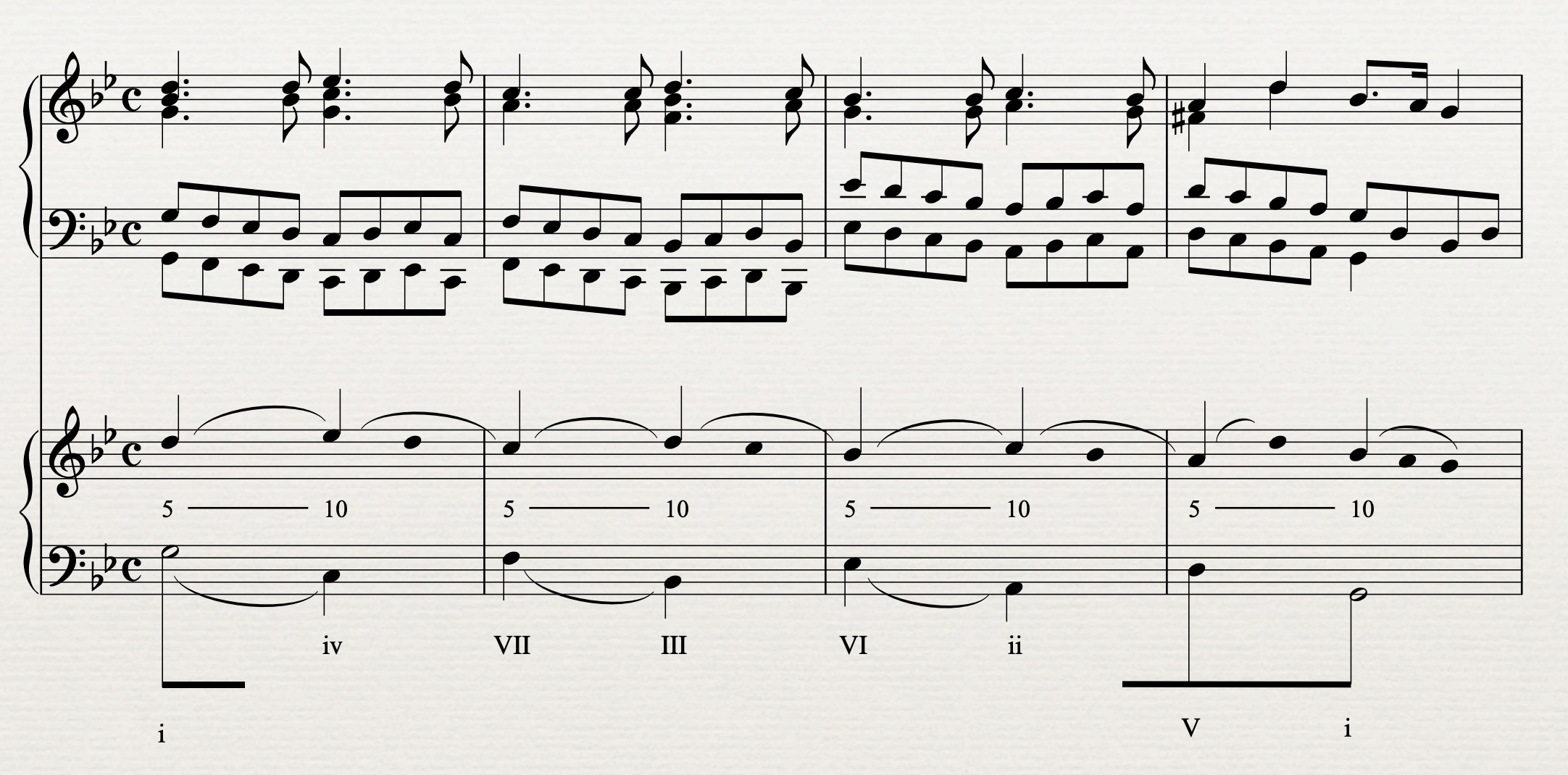AP Music Theory 🎶
72 resourcesSee Units
Just like melodic sequences, harmonic sequences occur when a segment of chords is followed by the same progression of chords transposed up or down by some interval. For example, we may start with a I-V progression in Major, and then transpose this pattern of chords down a second, we end up with a viio-ii progression. Usually, the relative motion of the chords and the voice leading of the chords is also preserved.
Here’s an example of a harmonic sequence:

Image via Music Theory Academy
There are two types of harmonic sequences: descending harmonic sequences and ascending harmonic sequences. If a harmonic sequence is descending, this means that for each iteration of the sequence, the harmonies are descending by some interval. In the example above, the harmonic sequence is characterized by descending fifths, meaning that the pattern moves from Am to Dm to G to C to F and so on. Each time, the root of the chord decreases by a fifth.
If the sequence were to instead ascend by fifths, the root of the chord might move from Am to Em to Bdim to F and so on.
Notice that just because the root of the chord is ascending or descending, it is not necessarily true that the actual notes are either ascending or descending. When writing harmonies with proper voice leading, it is important to keep the notes in each voice in the same general range, and to avoid crossing voices or overlapping the ranges of voices. For that reason, the root of the chord may ascend or descend depending on voice leading rules.
Also, notice that a harmonic sequence that descends by fifths is the same thing as a harmonic sequence that ascends by fourths, and a harmonic sequence that ascends by thirds is the same thing as a harmonic sequence that descends by sixths.
How do we differentiate between the two? First of all, we always try to characterize harmonic sequences in terms of fifths, thirds, or seconds. The most common types of harmonic sequences are descending fifths, descending thirds, and ascending seconds. So, if you notice that the root of a chord is ascending by sixths, you should probably interpret this progression as a harmonic sequence that is descending by thirds. Follow the same rule for sequences that are ascending or descending by fourths.
Second, we can look at the upper voices and notice whether the melodic line is generally ascending or descending. If we notice that the melody is primarily ascending, then we might choose to characterize a harmonic sequence as ascending, and if we notice that the melodic line is primarily descending, we would prefer to characterize the harmonic sequence as descending.
Fonte, Ponte, and Monte
Depending on whether the harmonic progression is ascending, descending, or neither, we can characterize it as monte, fonte, or ponte.
Monte, meaning mountain in Italian, means that the harmonies are ascending in a harmonic sequence. Often, the melodies will also ascend along with the root of the chord. Composers will employ monte harmonic progressions when they are trying to create tension and ascend to the climax or a dramatic part of a piece. Monte harmonic sequences are therefore usually accompanied with a crescendo and an increase in non-chord tones and embellishments so as to make the melodies more dense and complex.
One example of a monte sequence can be found in the first movement of Beethoven's Symphony No. 5, in the famous four-note motive that starts the piece. The motive is repeated in a sequence of ascending chords, each one a semitone higher than the previous one. This creates a sense of tension and dissonance, as the chords move smoothly but in unexpected ways.
Another example can be found in the music of Chopin, in his Prelude Op. 28 No. 15, known as "Raindrop Prelude". The piece is based on a monte sequence of chords that move stepwise, creating a sense of tension and dissonance and adding to the melancholic atmosphere of the piece.
Fonte, meaning fountain or well in Italian, occurs when harmonies are descending in a harmonic sequence. In a similar fashion to monte sequences, melodies will usually descend along with the harmonies. Usually, fonte sequences move towards resolution to the tonic chord, and they imply a decrease in tension and drama in a piece.
An example of a fonte sequence can be found in the first movement of Mozart's Symphony No. 40, where the sequence of descending fifths creates a sense of stability and resolution. The main theme of the symphony is repeated in a sequence of descending fifths, creating a sense of climax and resolution.
Another example can be found in the music of Bach, in his "Brandenburg Concerto No. 3". The piece starts with a fonte sequence that creates a sense of stability and resolution, which adds to the joyful and lively atmosphere of the piece.
Finally, ponte sequences, which is Italian for bridge, is a delay of a harmonic sequence, where the harmonic progression is neither ascending or descending. Usually, we find ponte harmonies in the dominant section of a chord progression, and they delay the resolution to the cadence. This increases tension in a phrase. Ponte harmonies will not have a cadence, since they are “standing” on the dominant tone.
One example of a ponte sequence can be found in the music of Debussy, in his Prelude "La fille aux cheveux de lin". The piece is based on a ponte sequence of chords that move by ascending fourths, creating a sense of tension and dissonance and adding to the dreamy and ethereal atmosphere of the piece.
Another example of a ponte sequence can be found in the music of Stravinsky, in his Rite of Spring. The piece features a ponte sequence that creates a sense of tension and dissonance, which adds to the primitive and wild atmosphere of the piece.
Minuets
It is important to note that fonte, ponte, and monte progressions were first defined when describing the form of a minuet. Minuets follow a structure that is composed of two sections: A-B. It is also known as "ternary form" because it is composed of three parts, even though it is not divided into three sections.
The first section, A, is called the "Minuet" and it establishes the key and the melody of the piece. It is usually in triple meter and has a moderate tempo.
The second section, B, is called the "Trio" and it is a contrast to the first section. It can have a different meter and tempo, and it is usually in a different key than the first section.
The Minuet and the Trio sections are usually repeated, and the Minuet section is usually played again at the end of the piece.

Image via Spinditty
Many composers have used minuet trio form, even when they aren’t writing minuets, and the form has been expanded into sonatas and symphonies by composers like Beethoven, Bach, and Mozart.
In minuet form, monte and fonte are both usually found in the contrasting middle of the piece (the B section). Monte is usually used at the beginning of this section, as the piece builds up to a climax, whereas fonte is usually used towards the end of this section. Fonte generally leads into a half cadence in order to prepare for the recapitulation of the A section.
Types of Harmonic Sequences
Harmonic sequences can be full-texture sequences or linear intervallic pattern sequences.
Full texture sequences refer to the repetition of a complete harmonic and melodic idea or phrase, often in a different key or with some variations. In other words, it's the repetition of a complete musical passage with the same notes, rhythms and chords.
In linear intervallic pattern sequences, only the interval between the outer voices forms a pattern. For example, if the interval between the outer voices alternates between a tenth and sixth, we call it a 10-6 linear intervallic pattern (LIP for short). The most common linear intervallic patterns are 10-10, 10-6, and 10-5 LIPs.
🦜Polly wants a progress tracker: Can you identify linear intervallic patterns in this excerpt of Handel’s Passacaglia? Remember to disregard non-chord tones and embellishments!

Image via SCFM Theory
Common types of harmonic sequences include descending and ascending fifths sequences, descending 3rds sequences, ascending 2nds sequences, parallel 6/5 chords, and Pachelbel sequences.
Descending and Ascending Fifths Sequences
Descending fifths progressions outline the circle of fifths, and usually consist of two fifth-related harmonies that make up each pattern. Then, this pattern descends by a second, e.g. I-V-viio-ii in Major. Descending fifth sequences can include all seventh chords, alternating triads and seventh chords, or alternating different inversions of seventh chords.
When writing descending fifths sequences for all root position seventh chords, you should alternate between complete and incomplete chords, eliminating the fifth, to avoid parallels. However, since sequences follow the voice leading of the initial pattern, it is okay to double the root in viio and iio chords.
Descending fifths sequences are often used in perfect authentic cadences or authentic cadences, e.g. V-I sequences, moving from the tonic to the predominant, e.g. I-IV, and moving from the predominant to the dominant, e.g. ii-V.
Ascending fifth sequences follow the same rules as descending fifths sequences, but the pattern is transposed UP a second (e.g. iii-vii-IV-I)
Descending Thirds Sequences
We usually see descending thirds sequences in the predominant area, e.g. (vi-IV-ii), or moving from the predominant to the dominant (ii-viio6). Ascending thirds sequences are also possible, but far less common than descending thirds. Usually, descending and ascending thirds sequences don’t use seventh chords.
Ascending Seconds Sequences and Parallel 6/5 Chords
Ascending 2nds are commonly seen in tonic to predominant movement, e.g. I-ii, predominant to dominant movement, e.g. IV-V, and dominant to tonic movement, e.g. viio-I. We also see these in deceptive cadences that move from the dominant to submediant (V-vi).
Parallel 6/5 chord sequences often ascend or descend by step. When writing these sequences, the LIP will be 6-6, which lacks melodic interest, so many composers will add a chain of suspensions or retardations in this sequence. This usually creates 7-6 suspensions when descending, or 5-6 retardations when ascending.
When writing ascending seconds, be careful to avoid parallel fifths!
Pachelbel Sequences
Pachelbell sequences follow the root progression of a descending fourth followed by an ascending 2nd. These are named after the famous Pachelbel Canon in D, which has root progression D-A-b-f#-G-D-G-A, i.e. I-V-vi-ii-IV-I-IV-V. When writing Pachelbel sequences, you can use all root position chords, or you can alternate between root position and first inversion chords to have a descending 2nd bass line.

Image via My Harp’s Delight
Browse Study Guides By Unit
🎵Unit 1 – Music Fundamentals I (Pitch, Major Scales and Key Signatures, Rhythm, Meter, and Expressive Elements)
🎶Unit 2 – Music Fundamentals II (Minor Scales and Key Signatures, Melody, Timbre, and Texture)
🎻Unit 3 – Music Fundamentals III (Triads and Seventh Chords)
🎹Unit 4 – Harmony and Voice Leading I (Chord Function, Cadence, and Phrase)
🎸Unit 5: Harmony and Voice Leading II: Chord Progressions and Predominant Function
🎺Unit 6 – Harmony and Voice Leading III (Embellishments, Motives, and Melodic Devices)
🎤Unit 7 – Harmony and Voice Leading IV (Secondary Function)
🎷Unit 8 – Modes & Form
🧐Exam Skills
📚Study Tools

Fiveable
Resources
© 2025 Fiveable Inc. All rights reserved.